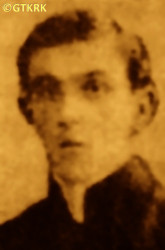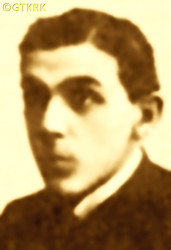Roman Catholic
St Sigismund parish
05-507 Słomczyn
85 Wiślana Str.
Konstancin deanery
Warsaw archdiocese, Poland
full list:
displayClick to display full list

searchClick to search full list by categories
wyświetlKliknij by wyświetlić pełną listę po polsku

szukajKliknij by przeszukać listę wg kategorii po polsku

Martyrology of the clergy — Poland
XX century (1914 – 1989)
personal data
surname
JĘDRUSZAK
surname
versions/aliases
JENDRUSZAK, JĘDRUSZCZAK
forename(s)
Marian
function
diocesan priest
creed
Latin (Roman Catholic) Church RCmore on
en.wikipedia.org
[access: 2014.09.21]
diocese / province
Kamianets diocesemore on
en.wikipedia.org
[access: 2013.05.23]
Lutsk‐Zhytomyr diocese (aeque principaliter)more on
www.catholic-hierarchy.org
[access: 2021.12.19]
date and place
of death
24.09.1937

Zhytomyrtoday: Zhytomyr urban hrom., Zhytomyr rai., Zhytomyr obl., Ukraine
more on
en.wikipedia.org
[access: 2021.09.17]
alt. dates and places
of death
Kievtoday: Kiev city rai., Kiev city obl., Ukraine
more on
en.wikipedia.org
[access: 2023.03.02]
details of death
For the first time arrested by the Russians in 1924 in Zbrzhysh.
Jailed in Kamyanets‐Podilskyi prison.
Released.
Harrased and interrogated a few times.
On 28.09.1927 arrested again.
Exiled — together with Fr Valery Szymański — for 5 years beyond Ukraine.
In the beginning of 1930 released and returned to Kamyanets‐Podilskyi region.
On 26.11.1931 yet again arrested by the Russians.
Jailed in Kamyanets‐Podilskyi prison.
In 12.1931 moved to Kharkiv prison.
Accused of anti–Russian agitation and illegal contacts with Poland.
On 11.11.1932 in Kharkiv sentenced to 5 years of slave labour by a criminal Russian OGPU Council kangaroo court.
Transported to ITL BelbaltLag concentration camp (Kuzema Station) where he slave at construction of Belamor canal.
Released in 1933.
Returned to Ukraine.
In 1935 arrested in Małyń.
Released after 5 months.
After closure of the church in Małyń in 1936 by the Russians moved to Zhytomyr.
There on 07.09.1937 (or 06.08.1937) arrested for the last time.
Accused of „counter–revolutionary activities among Polish population and spreading of anti–Russian propaganda”.
On 17.09.1937 sentenced to death — by the Russian genocidal «NKVD Troika» kangaroo court — and murdered in prison.
cause of death
murder
perpetrators
Russians
sites and events
11.08.1937 Russian genocideClick to display the description, Great Purge 1937Click to display the description, Zhytomyr (prison)Click to display the description, Kharkiv (prison)Click to display the description, ITL BelbaltLagClick to display the description, GulagClick to display the description
date and place
of birth
1891

Balbieriškistoday: Balbieriškis eld., Prienai dist., Kaunas Cou., Lithuania
more on
en.wikipedia.org
[access: 2022.06.29]
presbyter (holy orders)
ordination
1914

positions held
c. 1934 – 1936
administrator — Malyntoday: Malyn urban hrom., Korosten rai., Zhytomyr obl., Ukraine
more on
en.wikipedia.org
[access: 2020.11.07] ⋄ Immaculate Conception of the Blessed Virgin Mary RC parish ⋄ Radomyshltoday: Radomyshl urban hrom., Zhytomyr rai., Zhytomyr obl., Ukraine
more on
en.wikipedia.org
[access: 2021.08.20] RC deanery
till c. 1931
administrator — Kutkiwcitoday: Zakupne hrom., Kamyanets‐Podilskyi rai., Proskuriv/Khmelnytskyi obl., Ukraine
more on
en.wikipedia.org
[access: 2021.09.17] ⋄ Exaltation of the Holy Cross RC parish ⋄ Kamyanets‐Podilskyitoday: Kamyanets‐Podilskyi urban hrom., Kamyanets‐Podilskyi rai., Proskuriv/Khmelnytskyi obl., Ukraine
more on
en.wikipedia.org
[access: 2021.09.17] RC deanery
c. 1918 – c. 1927
administrator — Zbrizhtoday: Chemerivtsi hrom., Kamyanets‐Podilskyi rai., Proskuriv/Khmelnytskyi obl., Ukraine
more on
uk.wikipedia.org
[access: 2023.03.02] ⋄ St Anthony and St John of Nepomuk RC parish ⋄ Kamyanets‐Podilskyitoday: Kamyanets‐Podilskyi urban hrom., Kamyanets‐Podilskyi rai., Proskuriv/Khmelnytskyi obl., Ukraine
more on
en.wikipedia.org
[access: 2021.09.17] RC deanery — lived prob. in Lanckoron village
till c. 1927
administrator — Kutkiwcitoday: Zakupne hrom., Kamyanets‐Podilskyi rai., Proskuriv/Khmelnytskyi obl., Ukraine
more on
en.wikipedia.org
[access: 2021.09.17] ⋄ Exaltation of the Holy Cross RC parish ⋄ Kamyanets‐Podilskyitoday: Kamyanets‐Podilskyi urban hrom., Kamyanets‐Podilskyi rai., Proskuriv/Khmelnytskyi obl., Ukraine
more on
en.wikipedia.org
[access: 2021.09.17] RC deanery
till 1914
student — Zhytomyrtoday: Zhytomyr urban hrom., Zhytomyr rai., Zhytomyr obl., Ukraine
more on
en.wikipedia.org
[access: 2021.09.17] ⋄ philosophy and theology, Theological Seminary
others related
in death
SZYMAŃSKIClick to display biography Valerian
sites and events
descriptions
11.08.1937 Russian genocide: On 11.08.1937 Russian leader Stalin decided and NKVD head, Nicholas Jeżow, signed a «Polish operation» executive order no 00485. 139,835 Poles living in Russia were thus sentenced summarily to death. According to the records of the „Memorial” International Association for Historical, Educational, Charitable and Defense of Human Rights (Rus. Международное историко‐просветительское, правозащитное и благотворительное общество „Мемориал”), specialising with historical research and promoting knowledge about the victims of Russian repressions — 111,091 were murdered. 28,744 were sentenced to deportation to concentration camps in Gulag. Altogether however more than 100,000 Poles were deported, mainly to Kazakhstan, Siberia, Kharkov and Dniepropetrovsk. According to some historians, the number of victims should be multiplied by at least two, because not only the named persons were murdered, but entire Polish families (the mere suspicion of Polish nationality was sufficient). Taking into account the fact that the given number does not include the genocide in eastern Russia (Siberia), the number of victims may be as high as 500,000 Poles. (more on: en.wikipedia.orgClick to attempt to display webpage
[access: 2016.03.14])
Great Purge 1937: „Great Terror” (also «Great Purge», also called „Yezhovshchyna” after the name of the then head of the NKVD) — a Russian state action of political terror, planned and directed against millions of innocent victims — national minorities, wealthier peasants (kulaks), people considered opponents political, army officers, the greatest intensity of which took place from 09.1936 to 08.1938. It reached its peak starting in the summer of 1937, when Art. 58‐14 of the Penal Code about „counter‐revolutionary sabotage” was passed , which became the basis for the „legalization” of murders, and on 02.07.1937 when the highest authorities of Russia, under the leadership of Joseph Stalin, issued a decree on the initiation of action against the kulaks. Next a number of executive orders of the NKVD followed, including No. 00439 of 25.07.1937, starting the liquidation of 25,000‐42,000 Germans living in Russia (mainly the so‐called Volga Germans); No. 00447 of 30.07.1937, beginning the liquidation of „anti‐Russian elements”, and No. 00485[2] of 11.08.1937, ordering the murder of 139,835 people of Polish nationality (the latter was the largest operation of this type — encompassed 12.5% of all those murdered during the «Great Purge», while Poles constituted 0.4% of the population). In the summer of 1937 Polish Catholic priests held in Solovetsky Islands, Anzer Island and ITL BelbaltLag were locked in prison cells (some in Sankt Petersburg). Next in a few kangaroo, murderous Russian trials (on 09.10.1937, 25.11.1937, among others) run by so‐called «NKVD Troika» all were sentenced to death. They were subsequently executed by a single shot to the back of the head. The murders took place either in Sankt Petersburg prison or directly in places of mass murder, e.g. Sandarmokh or Levashov Wilderness, where their bodies were dumped into the ditches. Other priests were arrested in the places they still ministered in and next murdered in local NKVD headquarters (e.g. in Minsk in Belarus), after equally genocidal trials run by aforementioned «NKVD Troika» kangaroo courts.
Zhytomyr (prison): Russian investigative prison known for cruel interrogation methods used by the Russians. Execution site as well.
Kharkiv (prison): Russian criminal prison where in the 1930s a number of Catholic priests were held prior to being sent to Russian concentration camps.
ITL BelbaltLag: Russian Rus. Исправи́тельно‐Трудово́й Ла́герь (Eng. Corrective Labor Camp) ITL Rus. Беломоро‐Балтийский (Eng. White Sea ‐ Baltic Sea) — concentration and slave forced labor camp (within the Gulag complex) — headquartered in Medvezhjegorsk on Lake Onega, and in 1933‐1934 also in the town of Nadvoytsy (both then in the Karelo‐Finnish Republic, today the Karelian Republic). Founded on 16.11.1931, on the basis of the former ITL SLON camp (i.a. on the Solovetsky islands on the White Sea). Prisoners slaved at the construction of a canal between the White Sea and the Baltic Sea (opened on 30.06.1933). Later, as part of the newly created White Sea ‐ Baltic Sea Combine, managed by the criminal GPU (later the genocidal NKVD), slaved on forest clearing, in sawmills, on the construction of factories for wooden products and paper production, on the construction of hydroelectric power plants (Tulomskaya and Onda), a nickel factory and alcohol distilleries, construction of ports, and laying of railway lines., etc. One of heads of the camp was a Jew, Naftali Frenkel, regarded as the originator of the Gulag system. At its peak c. 110,000 prisoners were held there: e.g. 107,900 (12.1932); 70,373 (01.01.1934); 66,418 (01.01.1935); 90,290 (01.01.1936); 58,965 (01.01.1937); 79,232 (01.10.1938); 86,567 (01.01.1939); 71,269 (01.01.1941); 67,928 (15.06.1941). In 1938 there were 3,946 women among them. According to official data, 12,300 perished during the construction of the canal itself — according to unofficial data, from 50,000 to 300,000. The camp operated until 18.09.1941, and the entire project — in economic terms — turned out to be a total failure. (more on: ru.wikipedia.orgClick to attempt to display webpage
[access: 2022.09.02], en.wikipedia.orgClick to attempt to display webpage
[access: 2014.05.09])
Gulag: The acronym Gulag comes from the Rus. Главное управление исправительно‐трудовых лагерей и колоний (Eng. Main Board of Correctional Labor Camps). The network of Russian concentration camps for slave labor was formally established by the decision of the highest Russian authorities on 27.06.1929. Control was taken over by the OGPU, the predecessor of the genocidal NKVD (from 1934) and the MGB (from 1946). Individual gulags (camps) were often established in remote, sparsely populated areas, where industrial or transport facilities important for the Russian state were built. They were modeled on the first „great construction of communism”, the White Sea‐Baltic Canal (1931‐1932), and Naftali Frenkel, of Jewish origin, is considered the creator of the system of using forced slave labor within the Gulag. He went down in history as the author of the principle „We have to squeeze everything out of the prisoner in the first three months — then nothing is there for us”. He was to be the creator, according to Alexander Solzhenitsyn, of the so‐called „Boiler system”, i.e. the dependence of food rations on working out a certain percentage of the norm. The term ZEK — prisoner — i.e. Rus. заключенный‐каналоармец (Eng. canal soldier) — was coined in the ITL BelBaltLag managed by him, and was adopted to mean a prisoner in Russian slave labor camps. Up to 12 mln prisoners were held in Gulag camps at one time, i.e. c. 5% of Russia's population. In his book „The Gulag Archipelago”, Solzhenitsyn estimated that c. 60 mln people were killed in the Gulag until 1956. Formally dissolved on 20.01.1960. (more on: en.wikipedia.orgClick to attempt to display webpage
[access: 2024.04.08])
sources
personal:
biographies.library.nd.eduClick to attempt to display webpage
[access: 2014.12.20], christking.infoClick to attempt to display webpage
[access: 2018.09.02], ru.openlist.wikiClick to attempt to display webpage
[access: 2019.02.02], cathol.memo.ruClick to attempt to display webpage
[access: 2019.02.02]
bibliographical:
„Fate of the Catholic clergy in USSR 1917‐1939. Martyrology”, Roman Dzwonkowski, SAC, ed. Science Society KUL, 2003, Lublin
original images:
cathol.memo.ruClick to attempt to display webpage
[access: 2019.02.02], ipn.gov.plClick to attempt to display webpage
[access: 2019.02.02]
LETTER to CUSTODIAN/ADMINISTRATOR
If you have an Email client on your communicator/computer — such as Mozilla Thunderbird, Windows Mail or Microsoft Outlook, described at WikipediaPatrz:
en.wikipedia.org, among others — try the link below, please:
LETTER to CUSTODIAN/ADMINISTRATORClick and try to call your own Email client
If however you do not run such a client or the above link is not active please send an email to the Custodian/Administrator using your account — in your customary email/correspondence engine — at the following address:

giving the following as the subject:
MARTYROLOGY: JĘDRUSZAK Marian
To return to the biography press below:
 Click to return to biography
Click to return to biography










